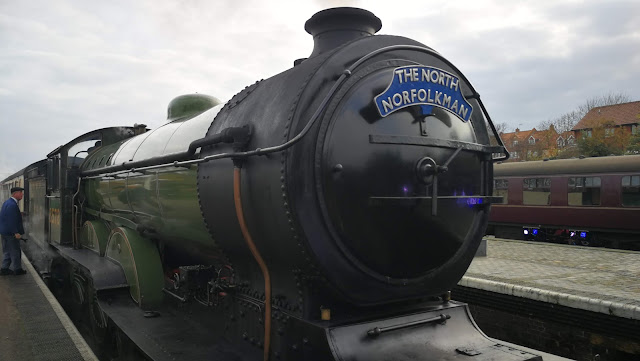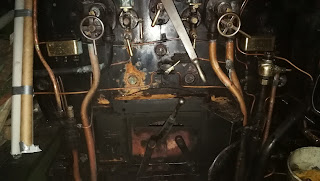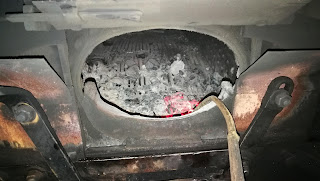A bit of an unusual turn this one - a Saturday and a private lunch train. I don't do Saturdays as a rule and a lunch train is a bit unusual - especially this one, where the passengers were to board the train at Holt and take one round trip to Sheringham and back to Holt; nothing odd in that but the dining set was at Sheringham, so we would make a couple of trips with empty stock. I'd been in touch with Fitter Mark during the week as there was some doubt about the sign-on time (it wasn't shown on the diagram) and late on Friday Mark told me we would have the B12.
Driver Nigel had been in all Friday getting it ready and there had been a warming fire in it all day, which was still hot when I checked it at 06:45 Saturday morning. I cleaned it with the bent dart and lit up:
Lighting up went OK, but the loco was pretty dirty. I spent the next couple of hours cleaning the paintwork:
The tender had been coaled and watered on Friday, which was handy as there was only me to clean. Fortunately, Fireman Ralph was there to look after the fire; we ashed out quite early, and took the engine back to the shed road to finish cleaning.
Driver Nigel is an ex-BR fireman, fountain of all knowledge and a thoroughly nice chap. Here he is getting ready to ash out, having reminded me that on this loco you do the back first, followed by the front if you don't want to get soaked:
Our first trip was light engine back to Sheringham to pick up our set. Nigel asked me what the two methods of working the railway are (meaning signalling). I was pleased to get this right; I've done several turns using both methods. They are:
Having checked the traffic roster, as has become my habit I was able to tell him that all boxes were open and so today we would be using Electric Token Block for the whole day; he was happy with that and asked if I had operated the Weybourne ground frame, which I have. In the event, the Weybourne signalman signed on on-time, which allowed us out of the yard under his control.
Time to get changed. On the way to the changing room, I passed the wheel lathe which had this coach wheelset set up on it. It looks like the near wheel is almost ready for another turn:
On the way to Sheringham, I assumed my usual role, calling out signals and hazards until Nigel told me that he preferred that unless it was an emergency, I was to leave calling out to the fireman - to save him being bombarded by folk calling out the same thing. Drivers are people and have different preferences! Later in the day, when I was firing, I realized this is quite a good approach and prepares you for when you are firing on your own, with out the assistance of a third man.
Having arrived at Sheringham, we coupled up. We were here 90 minutes before we were due out, mainly to get the heating on in the dining train which had sat idle for days and was apparently damp and cold.
I learned that the headboards are kept in the dining set. For this trip we are carrying white discs on the bottom middle & right lamp irons (as you look from the drivers seat) which denote the head code for a Class 5 Empty Coaching Stock train.
Fireman Ralph looked after the fire for most of the day, with us sharing the watering, coupling & run around duties. Watching Ralph's technique, I noticed that he crouched very low to look at the place where he wanted the coal - I took over for the empty trip down from Holt to Sheringham and the light engine trip back to Weybourne, and found that using the same technique I could get the coal much further towards the front of the box.
On the way down, I took over the fireman's duties entirely, keeping the fire ticking over and adding water to the boiler as much as I could - the objective was to make sure that we could arrive at Weybourne with the boiler full and the fire very low. In the event, we needed more fire to get back from Sheringham so build it up a bit more in the station but I was pleased to arrive on shed with the boiler full.
Despite several Third Man turns, this was the first time I had disposed the locomotive; on arrival the signal box was still open so we were able to get into the yard without using the ground frame - the Signalman kindly stayed on for an extra 30 minutes to let us in. We stabled the loco over the ash pit and Driver Nigel & I went underneath - him with the rake and me with the hose and whilst Fireman Ralph cleaned the fire, I soaked the ash and Nigel raked it out.
Nigel moved it to a road outside the shed - there was still about 160 psig on the clock and the boiler was full. I cleared out the pit.
Until next year, that's the last of the rostered services for the B12. My next four turns are on the new Norfolk Lights Express, which will give me four days on the Standard 4MT, two round trips plus prep and disposal each day - most of which will be in the dark!
Driver Nigel had been in all Friday getting it ready and there had been a warming fire in it all day, which was still hot when I checked it at 06:45 Saturday morning. I cleaned it with the bent dart and lit up:
Lighting up went OK, but the loco was pretty dirty. I spent the next couple of hours cleaning the paintwork:
The tender had been coaled and watered on Friday, which was handy as there was only me to clean. Fortunately, Fireman Ralph was there to look after the fire; we ashed out quite early, and took the engine back to the shed road to finish cleaning.
Driver Nigel is an ex-BR fireman, fountain of all knowledge and a thoroughly nice chap. Here he is getting ready to ash out, having reminded me that on this loco you do the back first, followed by the front if you don't want to get soaked:
Our first trip was light engine back to Sheringham to pick up our set. Nigel asked me what the two methods of working the railway are (meaning signalling). I was pleased to get this right; I've done several turns using both methods. They are:
- electric token block
- one train on line
Having checked the traffic roster, as has become my habit I was able to tell him that all boxes were open and so today we would be using Electric Token Block for the whole day; he was happy with that and asked if I had operated the Weybourne ground frame, which I have. In the event, the Weybourne signalman signed on on-time, which allowed us out of the yard under his control.
Time to get changed. On the way to the changing room, I passed the wheel lathe which had this coach wheelset set up on it. It looks like the near wheel is almost ready for another turn:
On the way to Sheringham, I assumed my usual role, calling out signals and hazards until Nigel told me that he preferred that unless it was an emergency, I was to leave calling out to the fireman - to save him being bombarded by folk calling out the same thing. Drivers are people and have different preferences! Later in the day, when I was firing, I realized this is quite a good approach and prepares you for when you are firing on your own, with out the assistance of a third man.
 |
| The train in the background is the Norfolk Lights Express, being fitted with its lights |
Having arrived at Sheringham, we coupled up. We were here 90 minutes before we were due out, mainly to get the heating on in the dining train which had sat idle for days and was apparently damp and cold.
I learned that the headboards are kept in the dining set. For this trip we are carrying white discs on the bottom middle & right lamp irons (as you look from the drivers seat) which denote the head code for a Class 5 Empty Coaching Stock train.
Fireman Ralph looked after the fire for most of the day, with us sharing the watering, coupling & run around duties. Watching Ralph's technique, I noticed that he crouched very low to look at the place where he wanted the coal - I took over for the empty trip down from Holt to Sheringham and the light engine trip back to Weybourne, and found that using the same technique I could get the coal much further towards the front of the box.
On the way down, I took over the fireman's duties entirely, keeping the fire ticking over and adding water to the boiler as much as I could - the objective was to make sure that we could arrive at Weybourne with the boiler full and the fire very low. In the event, we needed more fire to get back from Sheringham so build it up a bit more in the station but I was pleased to arrive on shed with the boiler full.
Despite several Third Man turns, this was the first time I had disposed the locomotive; on arrival the signal box was still open so we were able to get into the yard without using the ground frame - the Signalman kindly stayed on for an extra 30 minutes to let us in. We stabled the loco over the ash pit and Driver Nigel & I went underneath - him with the rake and me with the hose and whilst Fireman Ralph cleaned the fire, I soaked the ash and Nigel raked it out.
Nigel moved it to a road outside the shed - there was still about 160 psig on the clock and the boiler was full. I cleared out the pit.
Until next year, that's the last of the rostered services for the B12. My next four turns are on the new Norfolk Lights Express, which will give me four days on the Standard 4MT, two round trips plus prep and disposal each day - most of which will be in the dark!






No comments:
Post a Comment